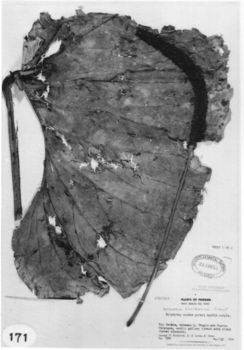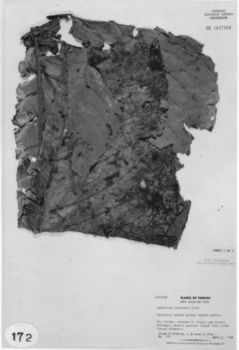


TYPE: Panama. Bocas del Toro: Río Teribe, between Quebrada Treglo and Puerto Palenque, 90-105m, Kirkbride & Duke 529 (MO 2132040, 2817264, holotype; NY, isotype).
Epiphyte; stem not seen.
LEAVES with petioles more than 20 cm long, quadrangular, winged, drying broadly sulcate on all 4 sides, narrowly and deeply sulcate adaxially near the apex, drying faintly reddish brown; geniculum 2-2.5 cm long; blades narrowly ovate, drying thinly coriaceous, greenish brown above, faintly reddish brown below; acuminate at apex, deeply lobed at base, 73-96 cm long, 58-63 cm wide, broadest at point of petiole attachment; anterior lobe 60-77 cm long, convex along the margin, the posterior lobes 27-29 cm long (from apex of sinus to outermost point), curved downward; sinus parabolic, ca. 20 cm deep, about as broad as deep, rounded at apex; both surfaces drying matte; midrib raised above and below, drying sharply 3-ribbed below, becoming 1-ribbed toward the apex; basal veins to 9 or 10 pairs, the first pair free to the base, the sixth to tenth coalesced to 14 cm, the posterior rib broadly curved, turned up along the margin; primary lateral veins to ca. 20 per side, raised in shallow valleys on upper surface, acutely raised below, departing midrib at 50-65 angle; interprimary veins much less prominent than like primary lateral veins; secondary and tertiary veins prominulous below; collective veins apparently rising from one of the lower basal veins ( not possible to be certain owing to poor preservation of specimens).
INFLORESCENCE with peduncle terete, 24 or more cm long. spathe green. deciduous, spadix purple; flowers square, the normal sized flowers (i.e., those lacking developing berries) 2.5-3 mm long (dry); 12-14 Flowers visible in the principal spiral; tepals semiglossy, the lateral tepals concave, weakly turned up-the alternate pair with the inner margins concave, prominently turned up.
INFRUCTESCENCE with immature berries exsented, rounded at apex, mature berries not seen. Figs. 171 and 172.
Anthurium teribense is endemic to Panama, known only from the somewhat incomplete type collection in Bocas del Toro Province at about 100 m in what was probably premontane wet or tropical wet forest life zones. The species is probably a member of section Belolonchium but its placement is tentative pending studies with living material. It is recognized by its large narrowly ovate leaf blade, its numerous primary lateral veins, its quadrangular petiole, its faintly reddish brown coloration on the lower surface of the leaf, and by its purplish infructescence. No other species has this combination of characters, and the quadrangular-winged petiole in particular is distinctive.
 |
 |
Bocas del Toro: Río Teribe, between Quebrada Treglo & Puerto Palenque, Kirkbride & Duke 529 (MO, NY).